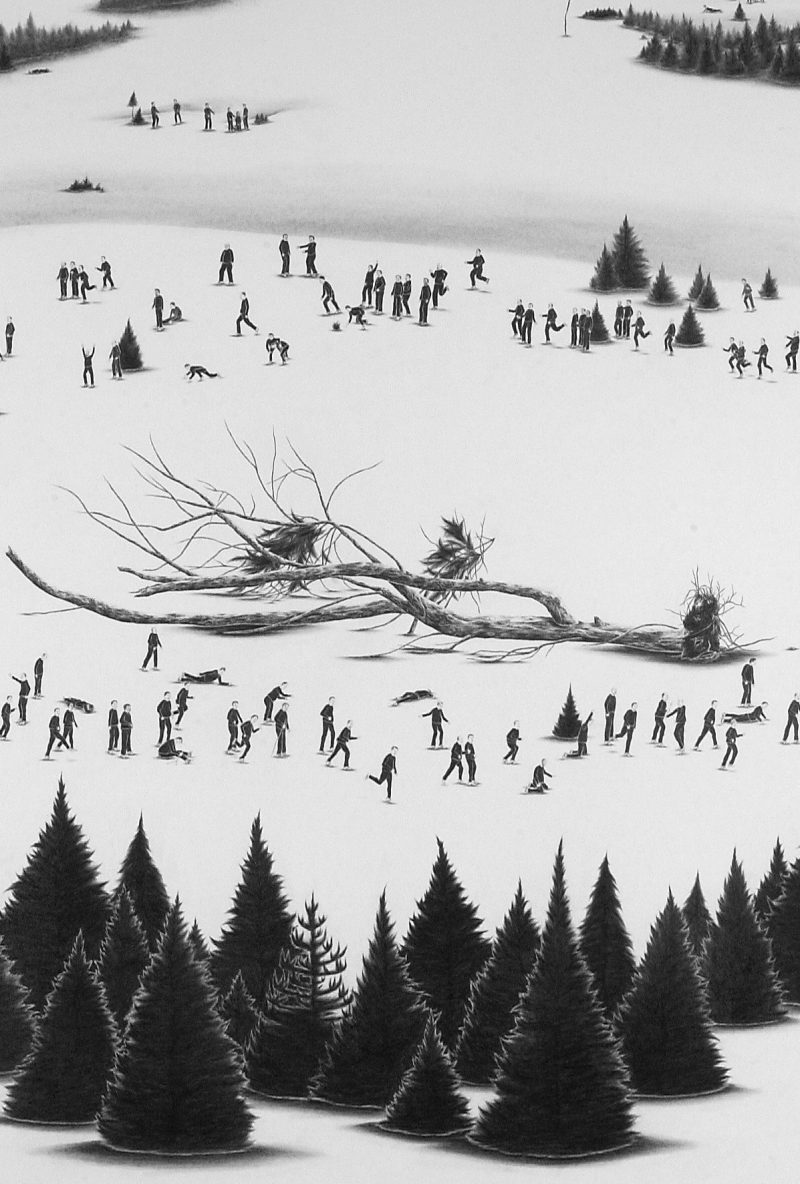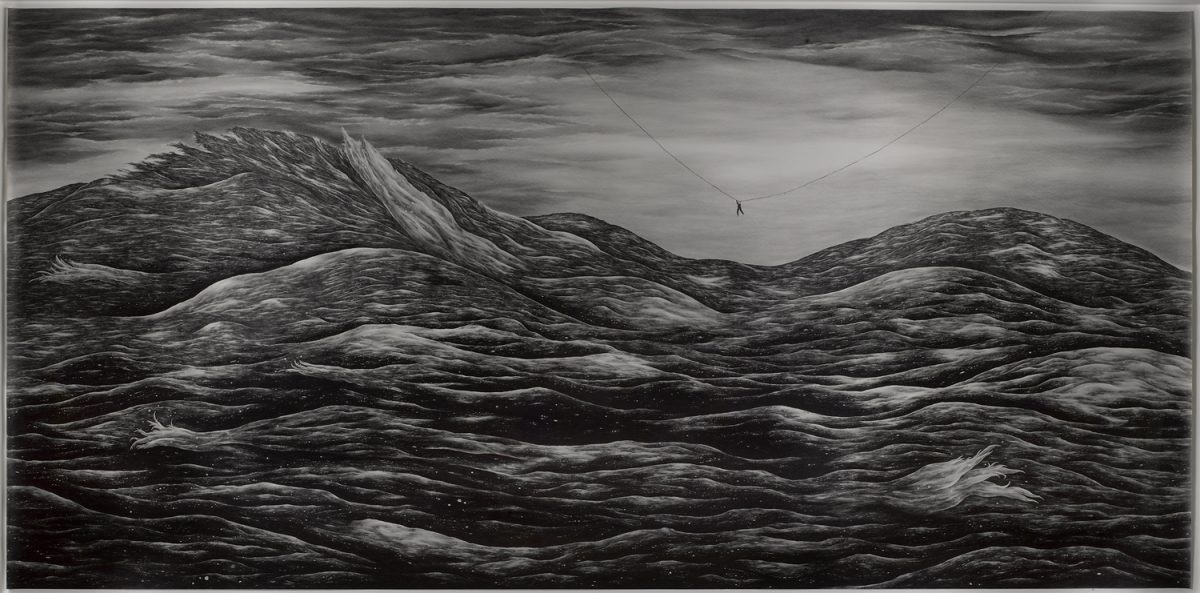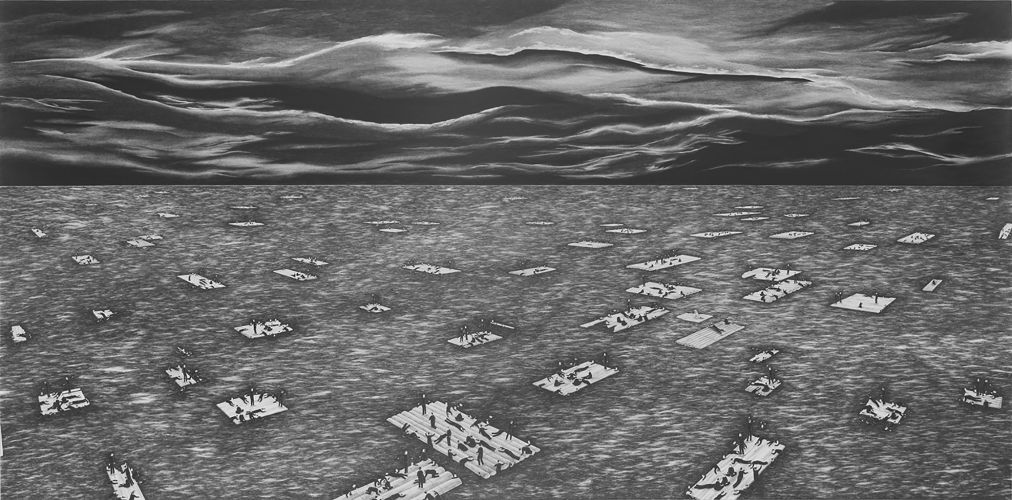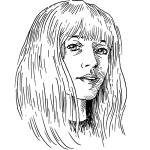I first saw Robyn O’Neil’s graphite-on-paper drawings at the Whitney Biennial in 2004. I spotted a giant triptych, a mountainous snow scene that spanned the enormous panels. I made my way over, intrigued by the countless details dotting the landscape—delicate stands of trees spaced with men, alone and in groups, all sporting identical black sweatsuits and engaged in calisthenics, falling down, lying on the white ground. Each meticulously drawn vignette was a little world of its own: five owls huddled together, a wandering elk, planes arriving in the distance. The title was Everything that stands will be at odds with its neighbor, and everything that falls will perish without grace.
A few years later, after moving to Texas, and through happy coincidence, I met O’Neil at the party of a mutual friend. Her warm, infectious laugh and animated enthusiasm are at first unexpected from the maker of such somber and ominous drawings. She was born in 1977 in Omaha, Nebraska, and the influence remains in her down-to-earth disposition, and in the individualism and straightforwardness that come through in her work. After graduate-study stints at Kings College in London and the University of Illinois in Chicago, she moved from painting to drawing, a medium she could work with at any time and in any location. Named artist-in-residence at Artpace in San Antonio in 2003, O’Neil finished her first large-scale multipanel drawing, the piece chosen for the 2004 Biennial. She has had numerous shows from that series, as it grew and evolved, in solo and group exhibitions all over the world.
O’Neil’s latest exhibition, as part of Dargerism: Contemporary Artists and Henry Darger, at the American Folk Art Museum, indicates that she is unafraid to acknowledge and applaud the array of things that inspire her. One evening in January of 2007, she sat with me in the oldest bar in Houston as we talked about the culmination of her long “end of the world” series, her process, and the concepts that inform her work.
—Hillery Hugg

Everything that stands will be at odds with its neighbor,
and everything that falls will perish without grace, 2003.
Courtesy Dunn and Brown Contemporary.
I. THE INCIDENT AT GODFATHER’S PIZZA
IN OMAHA, NEBRASKA
THE BELIEVER: So this month is the first time you’ve taken a real break since you started your “end of the world” series, seven years ago. Is this a normal way for you to work, without any kind of interruption?
ROBYN O’NEIL: I remember a distinct moment when I was about fifteen or sixteen when I made a decision. This is an awful thing to say, but I realized, Friends are taking up too much of my time, let’s put that on the back burner. My parents were a little weirded out. I was the opposite of most teenagers, and the opposite of my brother, where they had to try to keep him inside because he was always wanting to go out. But I made this really distinct choice where I had to be selfish, that was the only way I could see this, being an artist, working out for me. And I think, from that moment until this month, seriously, I’ve been going like a maniac. By the time I got to a point in my career where I could quit my job and focus only on making these drawings, it killed me to even take one night off. I mean, it would drive me insane, which is horrible, it’s a horrible way to be.
BLVR: But it’s a productive way to be.
RO: That’s true, it really is. And I must have realized that pretty early, for better or worse.
BLVR: I’m sure you’ve been told before that this latest series has an obsessive aspect to it. Did the medium—detailed drawing with graphite pencil—come first? Did the obsessive need to constantly keep working arise because you found and wanted to work in this medium? Or did you find this medium because it fits your habits and personality?
RO: I’ve always had obsessive tendencies since I was a kid, so I guess I did partly choose this medium for those reasons. I think one main reason that I chose graphite on paper was—and especially since I was making small ones—I wanted to be able to make everything from home, I didn’t want to leave my house. I went into grad school making paintings, really different, large, abstract, not so tedious—I could make tons of them.
BLVR: When you were doing the abstract paintings, did you feel like you had too much free time, like you couldn’t handle it?
RO: I did. It felt lazy, and I didn’t like that, so I guess I enjoy the sort of punishment I give myself. Making mechanical-pencil drawings that are of this scale is completely ridiculous, and when people find out that’s how I make them, they don’t know what to think—I mean, I look at this [points to a photo of one of her larger drawings] and I know it took me maybe three months of solid work, and I always think people looking at it won’t know—they’ll think it took me a couple of weeks or something. There are two sides to that, though, since I don’t want it to be all about how much time it takes me. Whenever I give a talk or a lecture, people are really obsessed with talking only about my process and I usually put a stop to that early on because I want to make a point. I don’t want people just to go, “Wow, you’re really a slave to your work,” because that’s not all it’s about—the image is what it’s really about, even though the process is obviously a part of it, too.
BLVR: Is this leaning toward compulsion related to that giant ball of collected fuzz you have at home in a Plexiglas case? Tell me about the provenance of that.
RO: Oh, the fuzz ball! Well, that was one weird day in the life of Robyn O’Neil, or just one day that turned me into something a lot stranger than I was before. I was a pretty normal kid until then. I guess I was about nine or ten, and I threw up in a Godfather’s Pizza in Omaha, Nebraska, with my family, right behind this kid in a high chair. I couldn’t get out in time to throw up in the bathroom or outside, and it was in front of everyone, and my dad, he’s a great guy, but he wasn’t exactly pleased with me, and he pulled me outside and was like, “Why didn’t you go to the bathroom if you knew you were going to be sick?” And, you know, I’m a little kid. So that night I couldn’t sleep, and I had this one blanket I had just started sleeping with and so I just started picking the fuzz off of it, and that’s when I started making it into a little ball. From then on, I couldn’t sleep very well as a kid, so I would make this ball, which you’ve seen is now huge.
BLVR: Are you still working on it?
RO: I stopped actively making it in high school because I had this jerky boyfriend who made me feel weird about it. I wouldn’t eat at restaurants after that incident, the throwing up. I would just sit there and draw. My parents got used to it—either avoiding taking me to restaurants or just letting me sit there and not order—and that was until tenth grade, when I had this jerk boyfriend—you know who you are!—and we were going to, of all places, to Chili’s. And so I forced myself, and I was kind of OK, I had to ease myself into it over time, and then I stopped working on the fuzz ball, too.
In college, I packed it away—I would never get rid of it, but I packed it away. And I was working on my abstract paintings, which were kind of obsessive in their own way, circles and dots, and my professor asked me, “Do you have anything else that’s like this, that’s about repetition?” and I just kind of stood there looking at him, and I said, “Yeah, I have this ball of fuzz I’ve been working on since I was about nine or ten and sometimes I still add to it,” and he said, “Bring it in”—and at that point it probably was the best thing I’d ever made, art-wise, although I didn’t think of it as art. It was like a baby to me.
BLVR: It was your safety blanket, deconstructed. So, do you think that where you grew up, coming of age in a place like Omaha, Nebraska, informs what you choose to do—the subject matter or the methods, or even just how you think about the work itself?
RO: It does in a lot of ways. When I first went to grad school, I started this series of the men in the landscapes. And I thought a lot about Omaha because I was living in Chicago, and I was only around highly intellectual and art-centered people, urban people, and there was a really rigid atmosphere about it. It wasn’t the kind of cultural background I had in Texas, where there is a really rich artistic environment, but it’s much more accepting, sort of glorifying folk art and outsider art. Chicago was not like that at all. It made me feel very uncomfortable, and I never felt happy being around that atmosphere. I really missed being around only normal people—that’s what I called them in my head, “normal people”—in fact, the first ones in the series, which I still own myself, are of my dad and his best friend, Marty. I just love my father and his friends.
BLVR: So was this the reason you chose to populate these works exclusively with men?
RO: It did have a lot to do with these men I grew up with in Nebraska. And I was reacting to what I was around in grad school. And I felt it was really radical at the time, and, in fact, it really was, because they were sort of silly the way they looked, that’s why I dressed them in sweatsuits, which they’ve been dressed in the whole time. I wanted them to be regular guys. I can’t stress enough how important it is to choose what the people you draw or paint are going to wear—and most of the time what I see is people drawing what they know, which is people in cool clothes, looking great, cool hairstyles, and that makes me cringe. I mean, these people don’t make me cringe when I see them around in real life. But, at least with me, that’s not what I wanted to talk about with my work. I wanted it to be about regular people, it’s not about anything economic, these people could have money, they could not have money, it’s a great social equalizer, everyone wears something similar when they work out.

These final hours embrace at last; this is our ending, this is our past (detail), 2007.
Courtesy Dunn and Brown Contemporary.
II. VOLUNTEER WEATHER-WATCHING
BLVR: In one of the last pictures of the series, These final hours embrace at last; this is our ending, this is our past, there is one man, suspended above a giant wave, holding on to a fraying thread. Is there anything in these last pictures that hints to where the next work might go? The men are gone now, forever?
RO: Actually, there were people who saw this last piece in the series, A Birth in Grief and Ashes, with the floating world in the sky, and they felt like it was some kind of hopeful message or something, because the whole rest of the show is really, really bleak.
BLVR: So maybe they were grasping for something.
RO: Probably. I led them to that dark place. But really, this floating world is based on the legendary tales of Magonia. The word originally came from a series of events in France around 800 AD, with folklore about ships navigating the clouds, and it was used to describe the place in the sky from which things—animals, objects—mysteriously fall. People really did believe in this story, that there were people who lived in the skies and had these cloud-ships, some people claimed they fell from these ships onto Earth. And there are thousands of reports all over the world about organic materials raining down: ants, blood, eels. I had been doing research on the study of natural phenomena, and scientists still don’t know why this happens, you know, mud falls from the sky. Unfortunately, it’s mostly just UFO people who are into this stuff, but that’s OK. So some of this stuff was finding its way into the later work already.
BLVR: There’s the upside-down floating horse over the waves, as if it’s falling from the sky, The World Disrupted.
RO: There’s a funny story about that one: When they hung that one for a show they hung it the other way around so the horse was right-side up, like he was running instead of falling, and the people bought it that way! I saw it on the website and I was like, Did they just mess it up for the website? But, no, it was wrong for the show, they took it to a fair and had it the wrong way, the whole thing.
BLVR: Did you let them know it was wrong?
RO: Yes, I mean, the collectors had it hanging in their house wrong, but they ended up thinking the whole thing was hilarious and had no problem hanging it the proper way. Anyway, I think the reason I was drawn so strongly to the Magonia legends and folklore was something that’s not directly connected to my work but it’s something that’s so clear when I think about it, and that’s the weather. I’m enormously affected by it; I’ve been a volunteer weather-watcher for years now.
BLVR: Are you serious?
RO: I started in college. You take the highs and lows of the day. You take the temperature.
BLVR: Is this at home?
RO: Yes, it’s in our house, in our kitchen.
BLVR: Do they send it in a kit or something?
RO: Yes! And a rain gauge. And so I have that in the backyard and you dump it out at the end of the day.
BLVR: You’re the Nielsen family of weather.
RO: Exactly—I always wanted to be a Nielsen watcher, too. So you send them the information—I used to mail it in, way back when I started, but now you can email it in. And of course you call in anything exciting at any time. It’s also important to know that I grew up in tornado alley, in Nebraska, and then I moved to north Texas. I’m this close to being a tornado chaser.
BLVR: I think your drawings use a dramatic perspective, a vulnerability, to show vividly how small we are in comparison.
RO: I want us to feel small. Because we are. The funny thing is, I don’t walk through my day thinking about this as much as I should, so I don’t know if my working on these drawings for months, where the art is bigger than the person by far, has anything to do with an attempt to be more aware of this; it gives me some sense of connection to the world and it takes me out of my head, or at least that’s what I am trying to get it to do. Maybe it helps a little bit.
BLVR: Well, at least the moment of creation can do that, if nothing else.
RO: I agree, that’s the best part of the whole thing, losing yourself.
BLVR: So how do you work? I remember you mentioned you don’t like natural light when you’re drawing. Are you the only artist in the world who has this preference?
RO: I probably am. I do, I hate it, I block it out. I don’t like natural light in my studio. I don’t know where this comes from. I just don’t like the way it makes me feel when I’m drawing. Even in school, there would always be this one studio without windows that no one else wanted and I would take it happily. I will work and then go outside with my dog and take a walk. I like natural light in my real life, just not when I’m working. I like to feel very isolated.

Masses and masses rove a darkened pool; never is there laughter on this ship of fools, 2007.
Courtesy Clementine Gallery.
III. “SMASHED BUTTERFLIES ON THE WINDSHIELD”
BLVR: So you told me recently you’ve been doing some research at the New York Public Library. Was that for a new project?
RO: Hmm, how to say exactly what I was doing… When I first read Lolita, I didn’t know anything about Nabokov and his butterfly collection because I was young and hadn’t done any research about him at all. But I always remembered the scene with Humbert Humbert driving away after his first real sexual encounter with Lolita and this description of smashed butterflies on the windshield. It was an image that stuck with me for a long time. So when I later learned how much butterfly collecting and drawing had been a part of Nabokov’s life, realizing that that sort of influence could penetrate into a story in such a powerfully subtle way made me crazy with excitement—and made me realize that those are the ways I want my influences to seep into my drawings. I never want them to be so obvious, although it’s creepy sometimes when certain writers can really pick out scenes from writing that I don’t think anyone could understand. Writers do that. Artists don’t usually pick up on those at all. It’s usually people who are gifted with language who can pick up on those subtleties.
BLVR: So this is what you did with your first-ever break?
RO: Yeah, I spent it at the New York Public Library. I stayed with a friend and set about trying to convince the archivists to let me into the archives.
BLVR: You have to convince them?
RO: Well, I had to lie. You have to have proof that you’re using their stuff for a writing project; you’re supposed to be a writer, which I’m not, obviously. You’re basically on trial if you really want to touch that kind of archive material.
BLVR: Is it the Flashdance-style panel, that kind of scenario?
RO: Yeah, it feels like it! There were two men, and they were in this really intimidating room where you have to stand in line with all these other people, these writers, people who have come from all over the world, Germany, Japan, Honolulu. I met the most amazing people in that line who were all waiting to touch these materials. Have you ever done that, gone and tried to see some of this stuff?
BLVR: No, I had no idea it was such a rigorous selection process.
RO: Well, you should, it’s amazing. I mean, it makes sense that they make you go through it, because there I was holding these notebooks, and looking at his handwritten notes. And in fact, I feel a bit guilty about it, because I don’t even trust myself: I was tempted to run off with something! But I brought them proof that I am really an artist and they denied me at first; I had to prove that somehow it was going to be related to the written word. So I went back to my friend’s apartment and tried to think of what I could do and basically I just went back and lied and said that a curator was writing an essay about my work and that she needed this material to complete it. So they let me in.
There’s a certain area that has just notes from selected fiction writers, and so I saw specific lines being figured out on notebook paper. And, I mean, I’ve seen images of this before, but Nabokov used a lot of index cards, with just a word or something that excited him, with the definition or whatever. And I just got to go through it. I don’t even know exactly what I was looking for, but it did validate that all of the research I spend a lot of time on, even if doesn’t all end up in my work directly, it does inform my work in the largest way possible. Recently, I was a guest artist/professor at Rice University and the University of Houston, doing studio visits with graduate and undergraduate students, and this is what I keep trying to tell younger artists, because so many of their ideas come from, like, “I love Bob Dylan, so I’m going to make… portraits of Bob Dylan!” You know? That kind of literal transcription of their own interests or influences instead of something more subtle and powerful. I think you want to jar people, or at least I want to jar people, and confuse them about these things, to make it exciting if they do talk to me about it and find out what’s in there.
BLVR: And this lesson is what you got from seeing Nabokov’s work? More than any literal influence or “aha” moment?
RO: I think so. Speak, Memory is the work that has affected me the most—just to see the way he thinks, to see his influences and his thought processes. I guess I was doubting my own sense of conceptualism. Sometimes I feel like I do have a great deal of conceptualism, but maybe not as much as other artists I like.
BLVR: Maybe you figured out that yours is not so much a conscious effort to apply some concept or another, but is a more organic, or subconscious, conceptualism, which can be just as powerful, just as influential?
RO: Yes, it validated for me some sense of my own process. Seeing how one of my favorite writers broke things down. For me, I started my drawings with these little pieces, which I think of as like sentences, medium drawings are like paragraphs and chapters, and these enormous ones, even if they’re simple imagery, like man versus nature—I mean, how much simpler can it get, yet epic, too—that’s like my novel. I think when I got to pore through these binders and binders of his ideas and see just one word and then all the associations that go with that word, triggering all sorts of ideas and inspiring story lines, that’s the way I work visually.
BLVR: It sounds like seeing Nabokov’s process got you to trust your instincts more. Or got you to feel more comfortable about trusting your instincts, which is probably the way you work anyway.
RO: Absolutely. You kind of need to get your own motifs. I needed to get my own fallbacks out of my head and just be a blank slate, and maybe my going to Nabokov was about that. It did come right after a major show, so I needed a recharge, especially after the end of a seven-year series like this. I am becoming more conscious about ignoring whatever I’ve done in the past, and I’m now trying to be receptive to the varied impulses my mind has. Perhaps the next series will be a total leap of faith.





